10 dishes from Peru you should try before you die
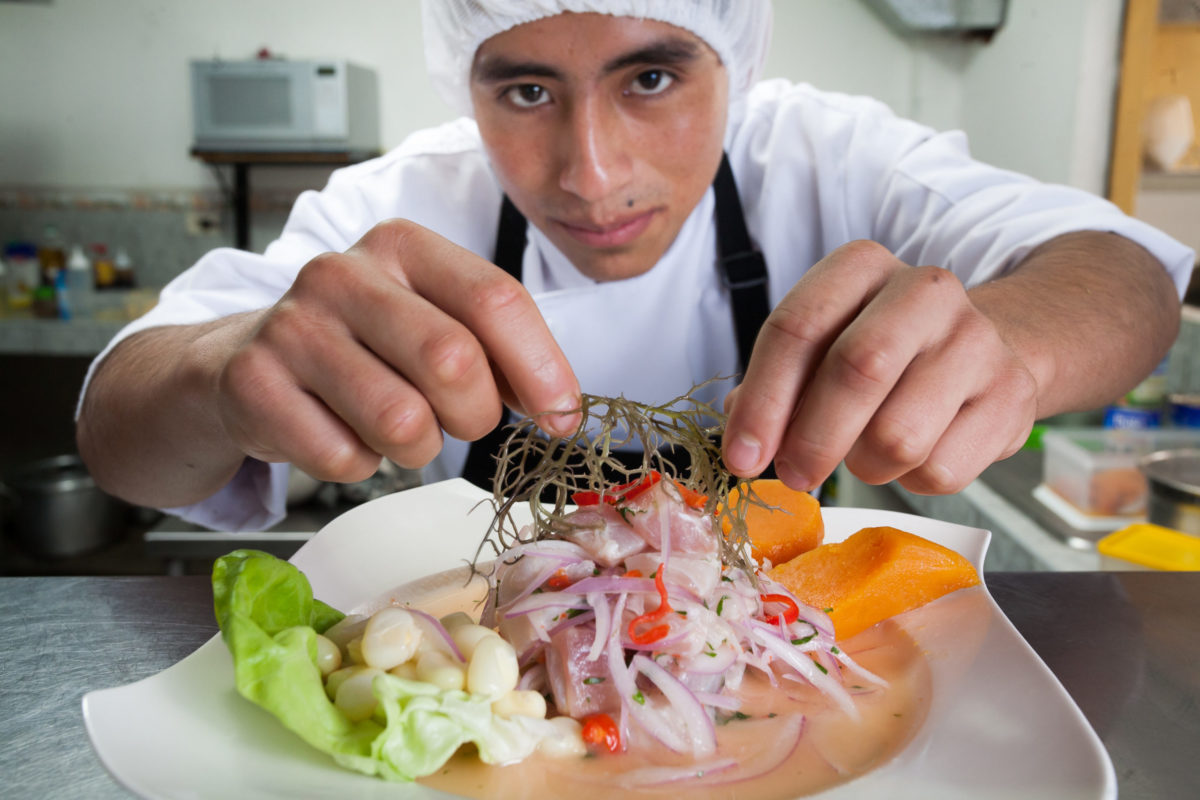
Peru, where traditional food meets the modern
People are attracted to Peru for many reasons, the spectacular Machu Picchu, Lake Titicaca or the mighty Andes mountains. Personally, however, one of the best reasons to visit the country is its gastronomy. When I created Introduction to Peru for bwd vacations, I wanted an itinerary where the guest could try several of Peru’s traditional foods and their new and more innovative dishes.
With the capital Lima, the nation is developing a reputation as a hotbed of inventive and unique dishes praised by food critics worldwide. Unknown to many people, at the World Travel Awards each year, Peru regularly features in the award for the “World’s Leading Culinary Destination”. It won the award eight times in a row between 2012-2019.
Those of you who have travelled with me in the past regularly hear me say,
“visiting a place is not just about seeing the sights; it is also about tasting it”.
Peru is, undoubtedly, a prime example of that idea.
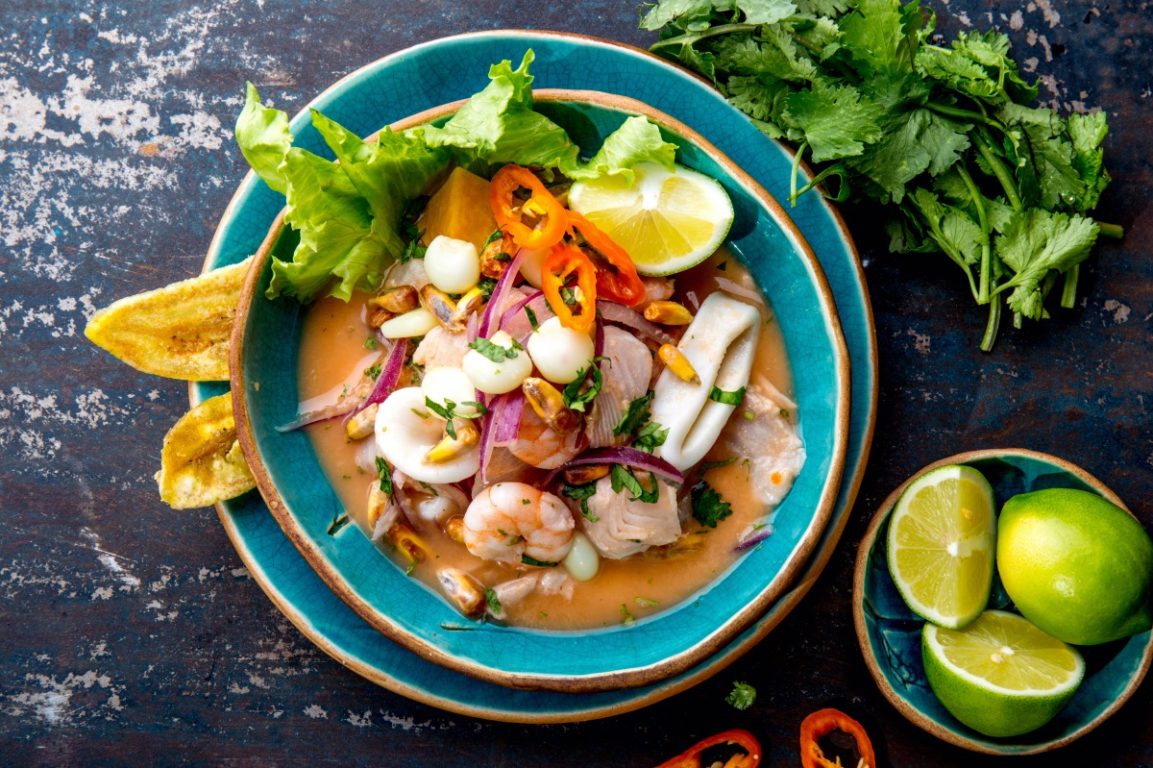
Ceviche: Probably Peru's most famous dish 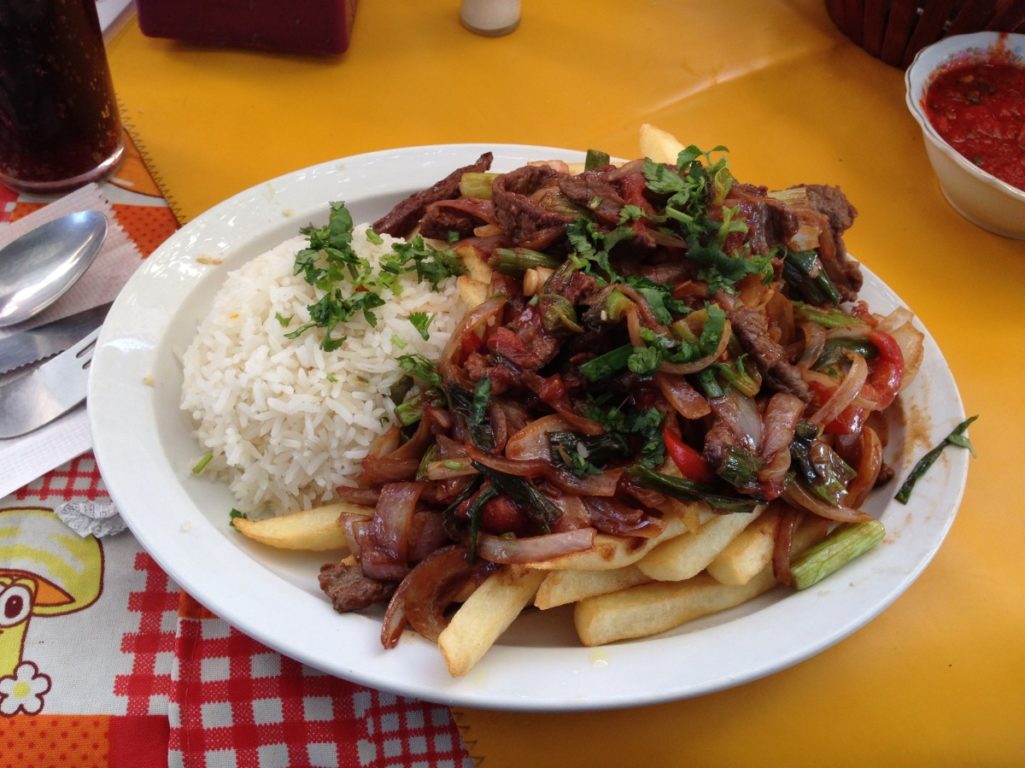
Lomo saltado: A marinated stir-fry traditionally made with beef 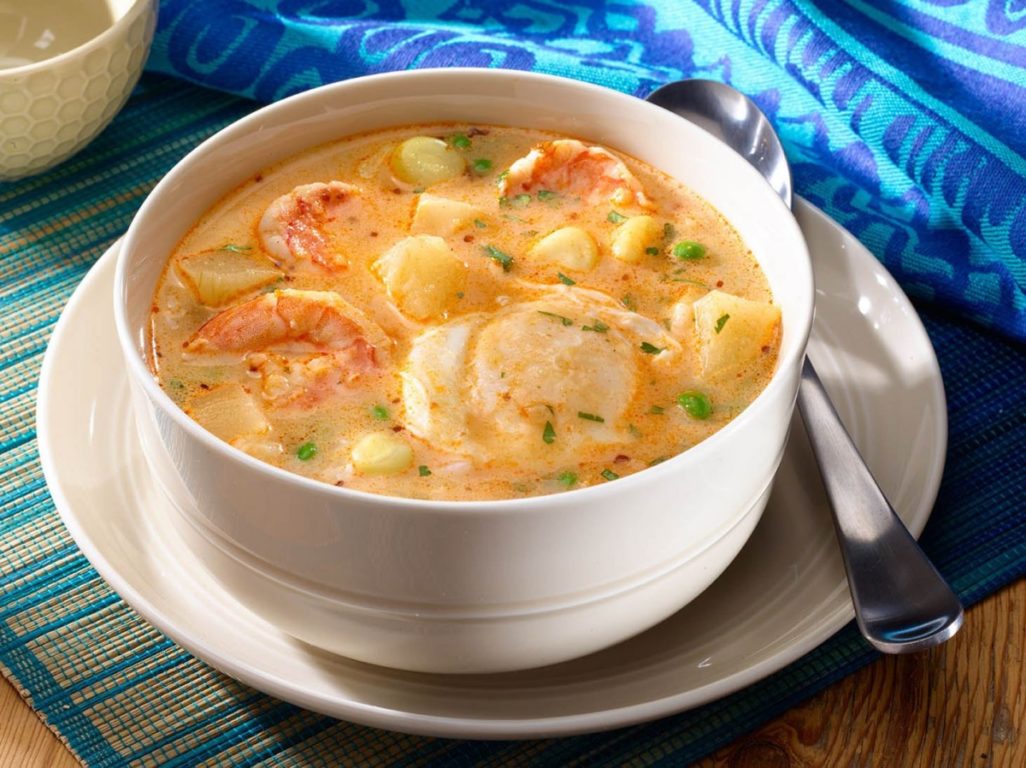
Chupe de Camarones: A shrimp chowder 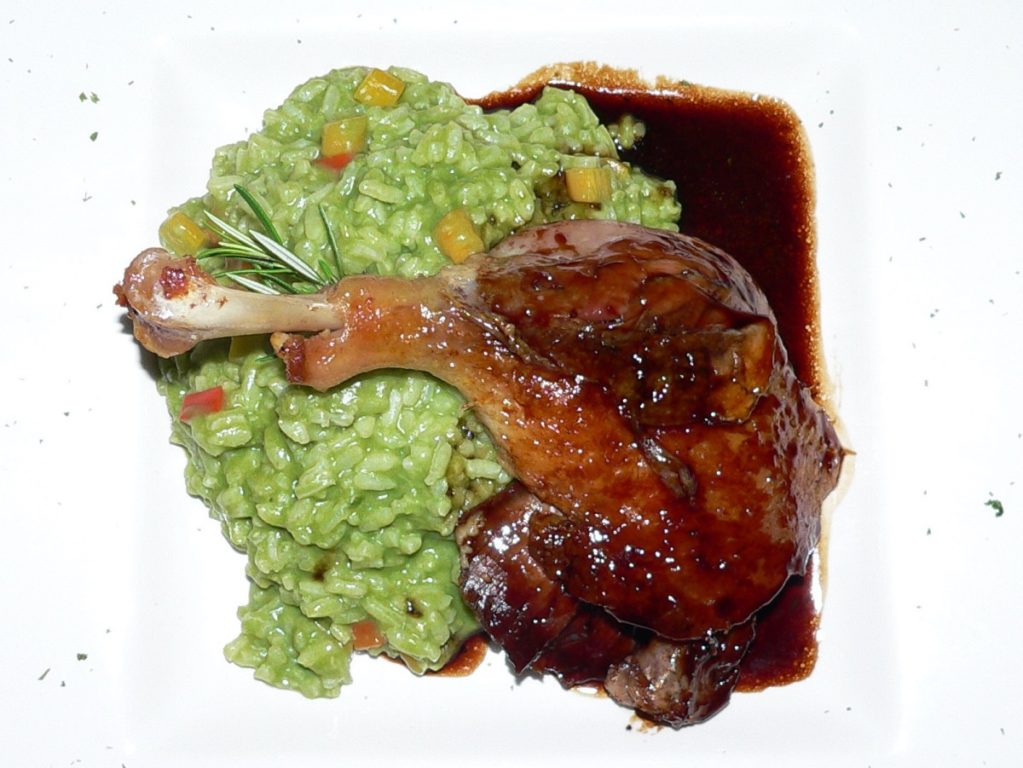
Arroz con Pato: The rice is cooked with cilantro and spinach to give it that green appearance 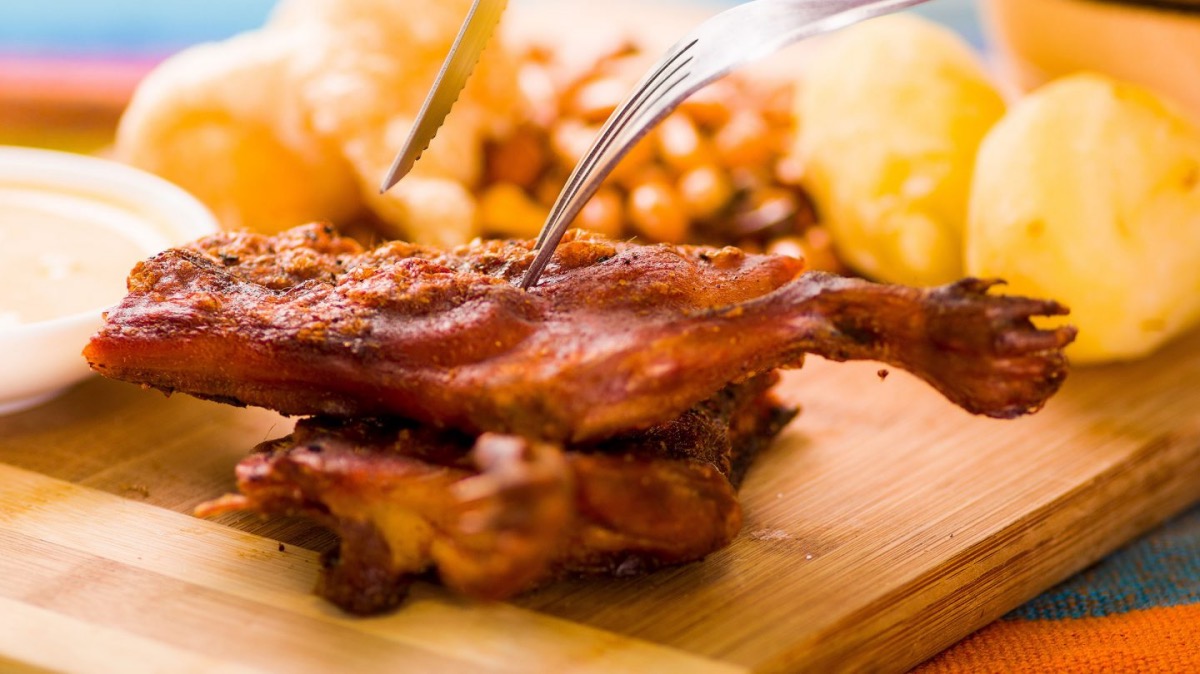
Cuy al Horno: Roasted guinea pig is certainly one of Peru's unique dishes 
Aji de Gallina: A slow-cooked Peruvian chicken stew made with local yellow chillies. 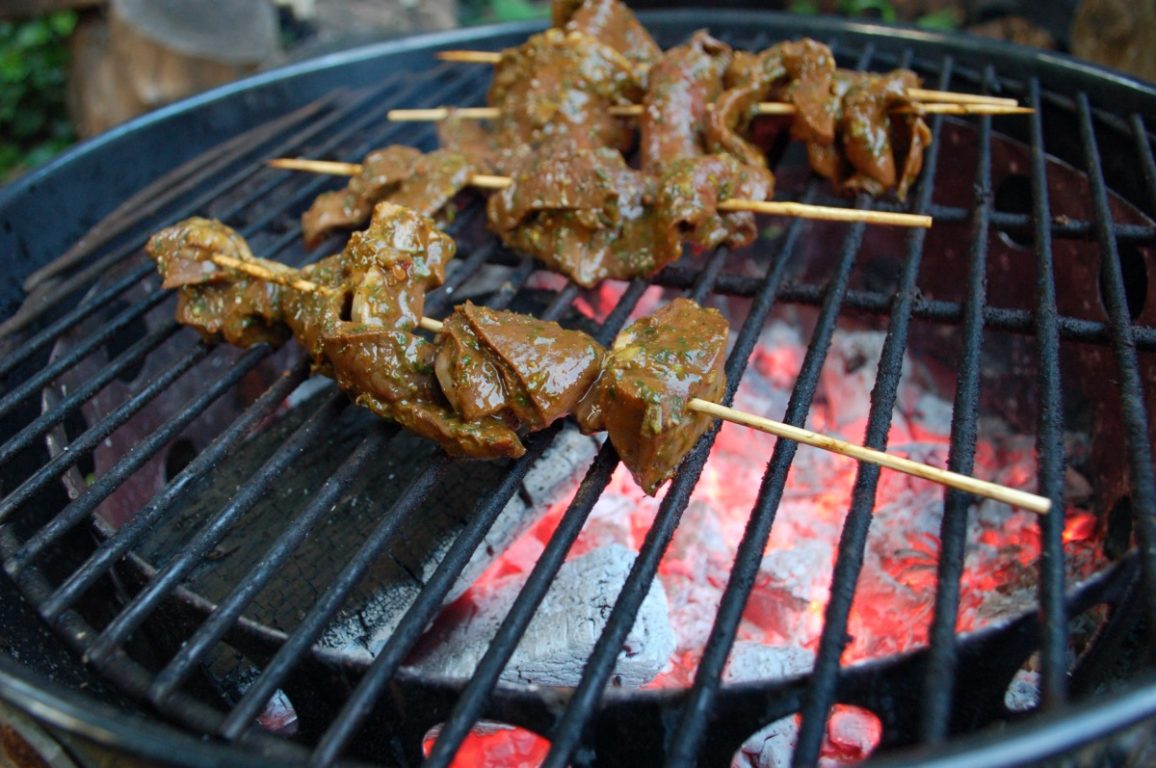
Antichuchos de Corazón: Barbecued skewers of marinated hearts 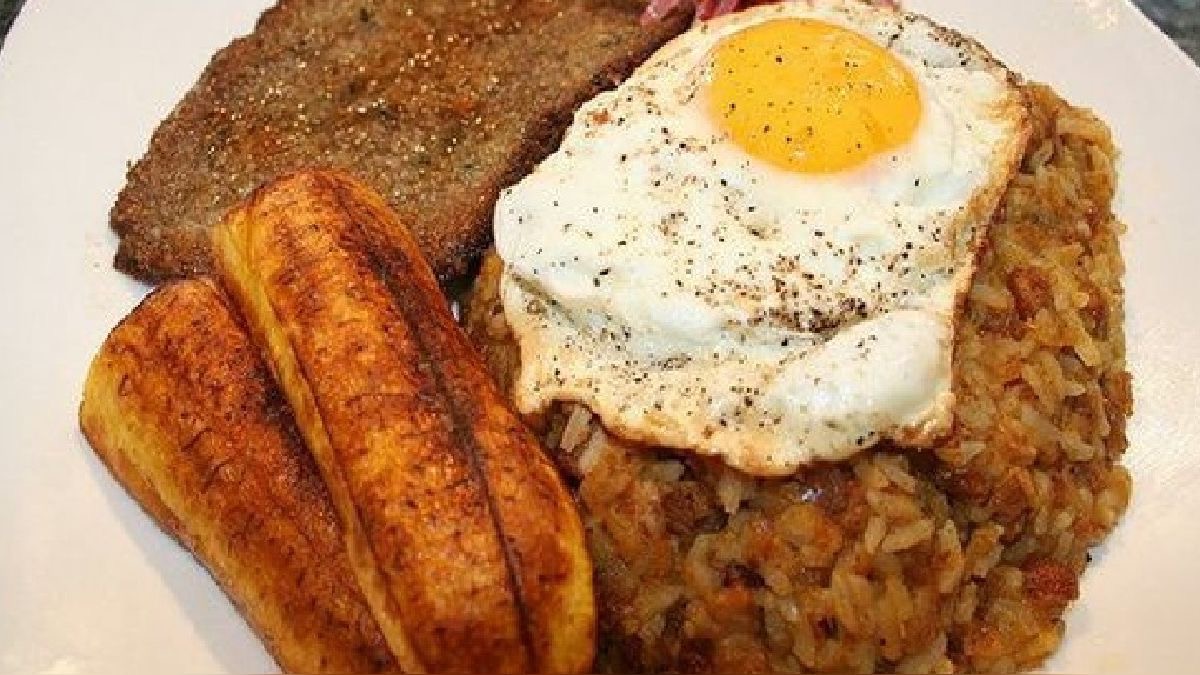
Tacu Tacu: One of my favourite Peruvian dishes and comes close to the perfect hangover cure 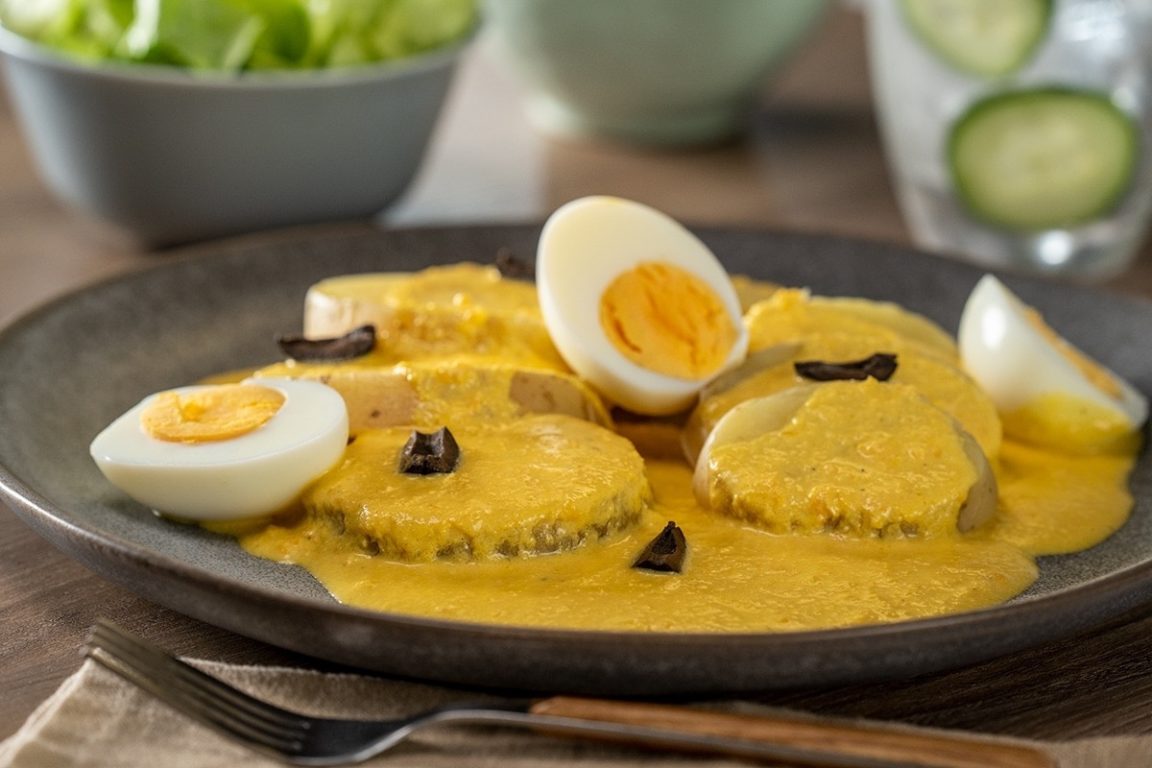
Papa de la Huancaina: A Peruvian potato salad that is served in nearly every household 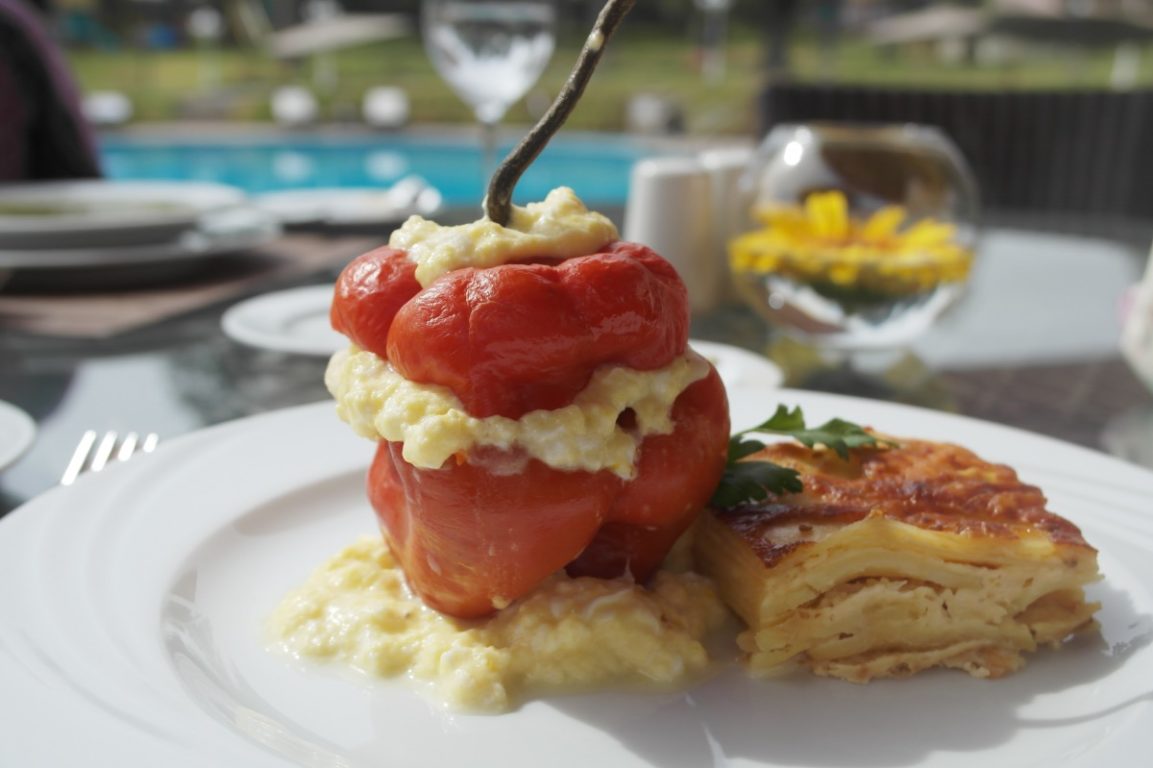
Rocoto Relleno: One for those who like spicy food
Origins of Peruvian Food
Throughout its history, Peru has received immigrants from many countries, each of which have left their culinary mark. Many Peruvian dishes are a fusion of native foods with immigrant cuisine from Europe, Africa and Asia.
The Spanish
The conquistadors who arrived at the end of the 15th, and early 16th century, introduced cows and beef to the region. At the start of the Spanish occupation, beef was costly and limited to the upper classes as there were very few cows in the country. The Spanish also introduced rice to Peru during the early years of the colony. The dish, however, didn’t reach its current-day popularity until the late 20th century, with the growth of the Chinese population.
The Africans
In the 8th century, the Moors from Africa invaded Spain and remained until being defeated in 1492. Afterwards, many were sent into slavery to work for their new Spanish lords and nobility. When the Spanish started to colonise South and Central America a few years later, those slaves were sent to the new world and used as labour in building the new colonies. As a result, many African herbs, spices and cooking techniques arrived in Peru and later incorporated into local dishes.
The Chinese
Thousands of Chinese immigrated to Peru in the mid-nineteenth century to work in agriculture. At the time, Peru abolished slavery, and workers were needed to replace the African slave labour given their freedom. Soon, the first Chinese restaurants sprang up in Lima, introducing the wok and the concept of stir-frying.
Through these settlers, soy sauce arrived in Peru and popularised the rice introduced earlier by the Spanish. Unfortunately for the Chinese, many of their traditional ingredients were hard to find in Peru, so they modified their dishes and incorporated many Peruvian elements. This hybrid of Chinese – Peruvian food today is referred to as chifa, and restaurants serving these dishes are trendy today.
Chifa derives from Chinese Mandarin and means ~ to eat rice.
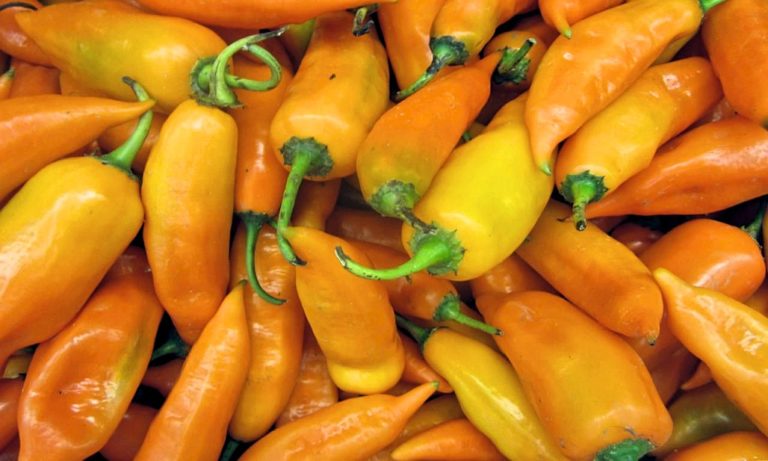
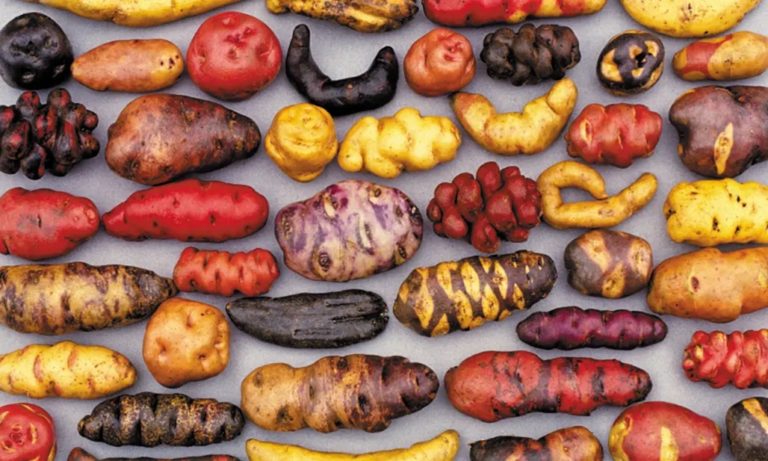
What kind of food do they eat in Peru?
Corn, rice, seafood, chillies & potatoes are the staple ingredients of many Peruvian dishes.
Did you know Peru has more than 3000 varieties of potatoes, the widest variety in the world.
Almost every restaurant you enter in Peru will serve a classic Peruvian soup or stew. They will usually contain quinoa, corn, vegetables and some type of meat.
Most meats, including chicken, beef, pork, or seafood, are commonly served with rice or potatoes for main courses.
Peru is not a country known for its desserts, it is more famous for its main meals, but they have a few worth trying.
Now we know all that, let’s look at my ten favourite Peruvian dishes that everyone should try before they die.
1. Ceviche
Arguably the most popular dish in Peru is ceviche and traditionally served as a starter or appetiser. Raw fish or shrimps, along with chillies, onions and salt, are marinated in citrus juice, most notably lemon or lime. The liquid’s acidity cures the fish, making it firm and opaque, absorbing the spices and fruit’s flavours.
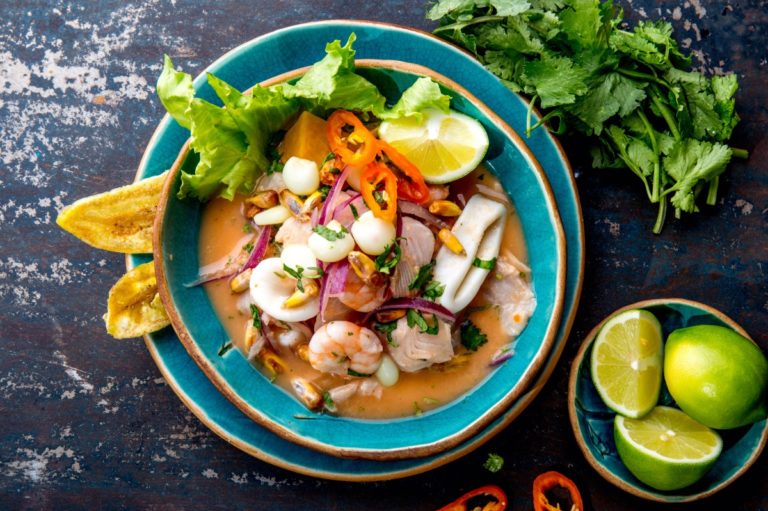
Lemons are prevalent in Peruvian cooking and are ideal for ceviche as they are very acidic. This high acidity cooks the fish, killing and harmful parasites of bacteria. It is widespread to serve ceviche in Peru with slices of cold sweet potatoes or with a side of corn-on-the-cob and garnished with red onions and cilantro. It is not unusual to see it spelt Seviche; its National Institute of Culture deemed it the correct historical spelling.
There is a National Seviche Day, celebrated on June 28 each year.
2. Lomo saltado
Lomo saltado, incredibly flavoursome but not spicy, is one of the most popular dishes in Peru. It is the quintessential international dish with ingredients and influences coming from Peru, Spain and China. It is a stir-fry of marinated sirloin steak with red onions, tomatoes, yellow chillies and crispy French fries and often served with rice. You will also find it, without the French fries, in a sandwich or used as the filling for an empanada.
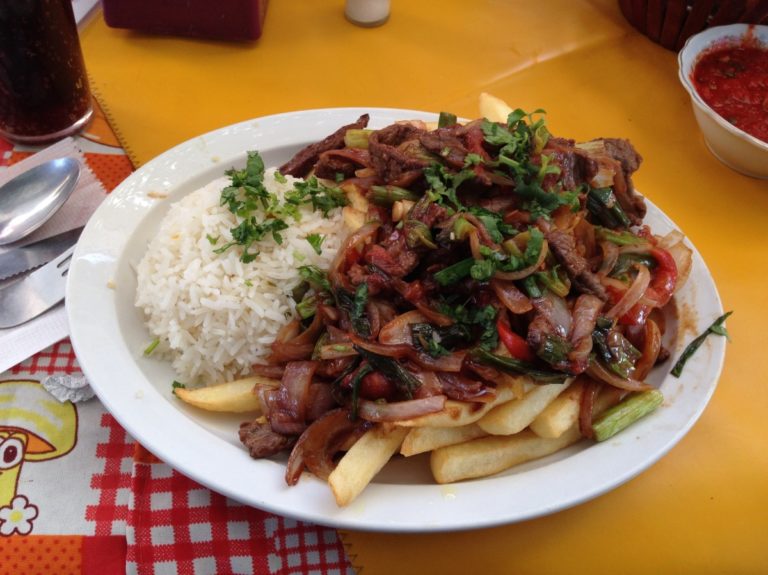
Saltado is a culinary term unique to Peru and does not exist in any other countries in South America or Spanish cooking terminology. The word refers to a stir-fry, and whilst the Spanish use “salteado”, most people associate the cooking style with the French term, sautée.
3. Chupe de Camarones
With more than 2400km (1500 mi) of coastline on the Pacific Ocean, seafood features prominently in menus across the country. Chupe de Camarones is a chowder that combines shrimps, beans, corn, garlic, tomatoes, chillies and a poached egg.
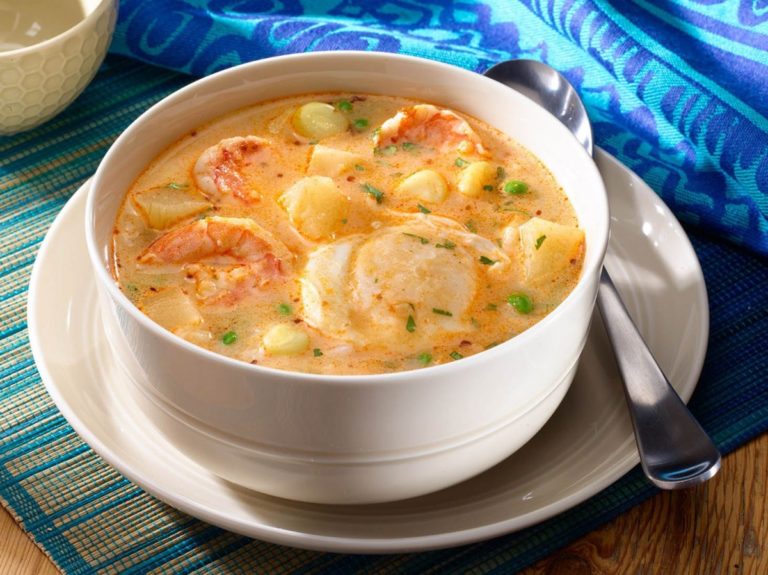
One of the ingredients in chupe de camerones is huacatay, a herb native to the Andes. It is a green leaf plant with a pleasant smell that tastes like a combination of basil and mint. Although typically made with shrimps, it comes with chicken, beef and shellfish versions also.
4. Arroz con Pato
Arroz con Pato or simply Rice with Duck, is one of Peru’s most typical dishes. In terms of cooking and seasoning, it is very similar to Arroz con Pollo, Rice with Chicken, found in many South American countries. The duck is fried with some stock, beer and pisco, a Peruvian brandy and then served with rice.

The dish originates in Chiclayo, in northern Peru, where the rice is green because of all the spinach and cilantro they put in it. Over time, it has become so popular that you can find it in most towns and villages the country’s length and breadth. I love it when they cook the rice with a dark beer which gives it a fuller flavour. Like many game types of meat, it goes very well with a glass of heavy-bodied red wine.
5. Cuy al Horno
In English, Roasted Guinea Pig, Cuy al Horno, is one of Peru’s most unique dishes. Cuy has been a Peruvian delicacy long before the Incas arrived in the 12th century. In those times, they were farmed like other livestock, such as pigs and horses, and were popular because they are much easier to breed and more nutritious.

I like to eat it with a stout or porter beer. It draws out the lighter flavours and adds a sweet counter to the saltiness of the cuy. It is almost impossible to eat a guinea pig with a knife and fork, so it’s best to do what the locals do, dig in and use your fingers.
6. Aji de Gallina
Aji de Gallina is a slow-cooked Peruvian chicken stew made with yellow chillies, walnuts, turmeric, garlic and other herbs. In English, it translates to “chicken chilli” and comes typically served with a hard-boiled egg and potatoes or rice.

The dishes’ origins are in Africa, where they combined almonds, milk sugar, and chicken or fish. In the 15th century, Spain began massive colonisation of Peru, bringing many African slaves and their recipes with them. With time, locals added yellow chillies to the recipe giving us the dish we have today.
7. Anticuchos de Corazón
In English, grilled hearts is a plate that is very common in many Peruvian restaurants. Many visitors pass on the dish because hearts are not typical in many countries. It’s a shame as it is delicious, mainly when it cooked on a BBQ or seared over an open flame. The hearts are usually beef but is in many areas, particularly around Cuzco, where they originate, they will serve alpaca hearts.

Traditionally, the hearts are cut into small cubes and then marinated in vinegar, chilli, cumin and garlic. I love them, as they have a beefy flavour, especially when eaten with a glass of good red wine. They are also relatively healthy, being very lean with next to no fat. It is popular street food and often found in the market or food stands.
8. Tacu Tacu
Tacu is one of my favourite dishes and comes close to the perfect hangover cure. It is made of rice, beans and chillies and often with the leftovers from the day before. For many, it is like a Peruvian version of the English dish bubble & squeak. Likewise, it is also pan-fried, so it becomes crispy on the outside yet soft on the inside.
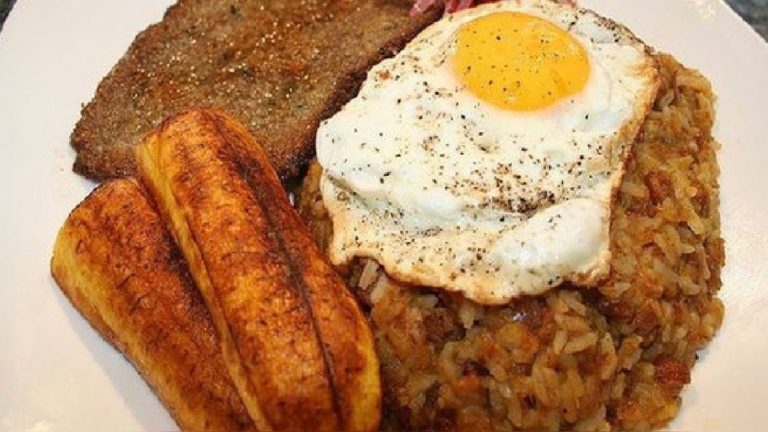
It is a dish that appears typically in local restaurants and served with a Sabana, a thin slice of steak, and a fried egg on top.
9. Papa de la Huancaina
Probably the most typical Peruvian appetiser that is served in nearly every household when guests visit. Like a potato salad but much more flavoursome, the potatoes are boiled then served with a creamy and spicy yellow sauce made from chillies. The sauce, made from fresh cheese, yellow chillies, condensed milk, and oil, is called Huancaina, hence the dish’s name.
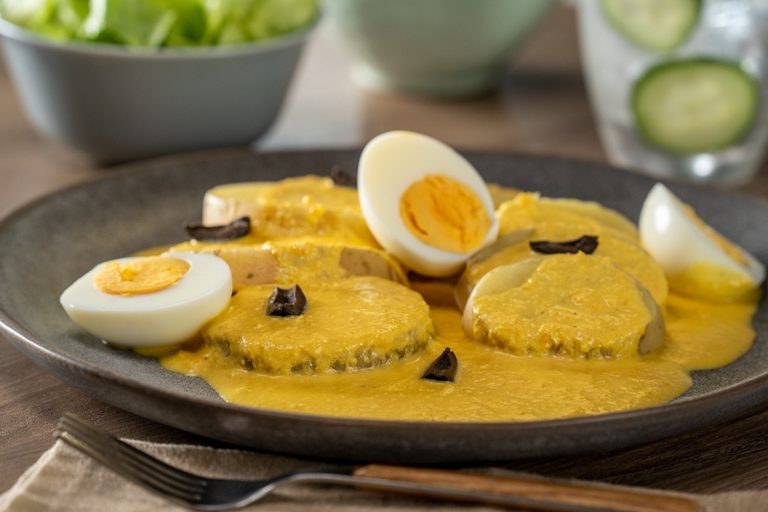
The plate comes typically served with a sliced boiled egg on top. Peru has very few vegetarian dishes, but Papa de la Huancaina is one of them.
10. Rocoto Relleno
Because I like spicy food, rocoto relleno is one of the first dishes I have when arriving in Peru. Rocoto is a type of pepper or capsicum that is much spicier than peppers in other countries. A filling of minced beef, pork, onion, pecans, and other spices are then stuffed inside the pepper, topped with cheese and grilled.

When having Rocoto Relleno, it traditionally comes with pastel de papa or potato cake. Pastel de papas are thin layers of potatoes and cheese baked in the oven.
Highlights of Peru by bwd vacations
For anyone wishing to try some of these incredible dishes in Peru, I recommend looking at Introduction to Peru by bwd vacations. This exciting itinerary includes many of Peru’s highlights, such as Lima, Machu Picchu, the Sacred Valley, Cuzco and Lake Titicaca, along with a fantastic selection of restaurants dining experiences. Small groups, maximum of 16, superb accommodation, no added extras and plenty of free time make bwd vacations an incredible holidaying experience.